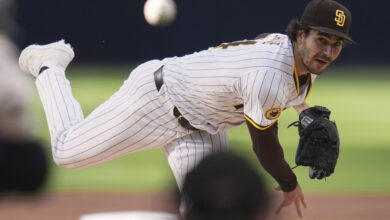
Tap Out: Heyward Has Ditched the Timing Mechanism in His Swing
“Don’t read the comments” is a common refrain among those who wish to avoid swimming in the fetid cesspools that so often follow online columns. But if I did that, I’d miss all kinds of legitimate stuff too. At the conclusion of my piece about Jason Heyward’s improved results of late, Aaron Weimer (sounds like a pseudonym to me) suggested that getting rid of the toe-tap timing mechanism John Mallee had helped to install this spring could be playing a role.
I’ve already written quite a bit about Heyward’s swing, so I won’t get into a redux of that here. If you’d like to read more about the evolution of his mechanics or what I perceive to be the psychological nature of some of the issues, I’d encourage you to check out those links. What I do want to touch upon here, albeit briefly, is the swing and what has changed with it.
[beautifulquote align=”right”]Heyward sees 65% fastballs, third-most in baseball and more than 8% higher than league average.[/beautifulquote]The toe-tap was supposed to help slow Heyward down and keep him from jumping at the ball. It accomplished the first half of the intended goal, but the result was that the big right fielder was frequently handcuffed by fastballs. Throughout his career, Heyward had seen fastballs at a little less than a 60% clip. That’s up to 65% this season, third-most in baseball and more than 8% higher than league average.
Take a look at this swing from August 13 in a game against the Cardinals. Heyward is set up well off the plate with an open stance that he closes via the toe-tap as Seth Maness delivers the pitch. It’s pretty awkward-looking from my perspective, particularly when the hands start up and then get tucked into his chest just before the swing, creating kind of a wood-chopping motion that resulted in too many grounders to the right side.
Now look at this at-bat from just four days later against the Brewers’ Tyler Cravy, who left a fastball out over the plate. Notice how Heyward simply waits back and takes a single step to really drive the ball. No hitch, just a pure swing. Were it not for Hernan Perez’s effort just shy of the wall, this ball probably goes for extra bases.
And that, as you probably recall, was shortly before Joe Maddon sat Heyward down for a few days. He’s been on a bit of a tear since then, including a home run in his third at-bat against Edwin Jackson.
And let’s take one more look at the “new” swing, this time resulting in a rocket Adrian Gonzalez was somehow able to snag.
In addition to eliminating the toe-tap, it looks like Heyward has closed his stance up ever so slightly. It’s perhaps only a matter of a couple inches, just enough to allow him to step fully into the pitch without the little intermediary dance move he’d been employing throughout much of the season. The other thing, and this might just be me seeing what I want to see here, is that the path of the hands seems to have improved a little.
While his first move is still to tuck them in a little, it appears he’s keeping them higher and and avoiding that tendency to roll over and beat pitches into the ground. I’m far from an accomplished swing analyst, but the evidence (more hard-hit balls, fewer grounders, better use of all fields) would seem to indicate that this is indeed the case.
[beautifulquote align=”right”]The subtraction of the toe-tap is far from a fluke.[/beautifulquote]I understand that we can’t draw firm conclusions on the basis of four individual swings, that would be silly. I also understand that Heyward has been tinkering with his mechanics all season, all his career, and that the addition of the toe-tap was no accident. Thus, its subtraction is far from a fluke. Now the question will be whether the positive results continue to manifest over the remainder of the season.
Go take a look at those clips again, or check out more at MLB.com. What do you think about the toe-tap, the stance, and the hands? Are there some real differences there and, if so, do you think they’ll result in sustainable improvement?

